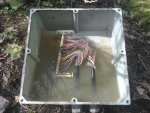Rampage_Rick
Senior Member
- Location
- British Columbia, Canada
Got a call about inoperative phones in one building. They've got a Nortel PBX with 50 odd phones in 5 buildings, 25-pair to each building.
Pull all the jumpers from both ends of the 25-pair and hook up my Dynatel 950. Half the pairs show 1300 feet, but a dozen pairs show 300 feet from one end, 1000 feet from the other. I'm thinking partial cable damage; perhaps it got nicked by an excavator. Move phones to good pairs and made plans to return in a few days.
A few phones drop out in only a day. Now I'm back with a wire tracer. Found a handhole buried under 6" of mulch. Find the 25-pair spliced with a BIX block. They did attempt to waterproof the splice by putting it inside a 12" PVC box, but that doesn't help much when the box fills with water...

Out of interest, the pairs originally in use were around 8-16, which correllates to the green crud on the BIX block.
Couldn't get a suitable enclosure in time, so I reused the PVC box and reconnected everything with UY2 Scotchloks. Also suspended the box near the top of the handhole, rather than have it sit on the bottom.
Pull all the jumpers from both ends of the 25-pair and hook up my Dynatel 950. Half the pairs show 1300 feet, but a dozen pairs show 300 feet from one end, 1000 feet from the other. I'm thinking partial cable damage; perhaps it got nicked by an excavator. Move phones to good pairs and made plans to return in a few days.
A few phones drop out in only a day. Now I'm back with a wire tracer. Found a handhole buried under 6" of mulch. Find the 25-pair spliced with a BIX block. They did attempt to waterproof the splice by putting it inside a 12" PVC box, but that doesn't help much when the box fills with water...

Out of interest, the pairs originally in use were around 8-16, which correllates to the green crud on the BIX block.
Couldn't get a suitable enclosure in time, so I reused the PVC box and reconnected everything with UY2 Scotchloks. Also suspended the box near the top of the handhole, rather than have it sit on the bottom.

